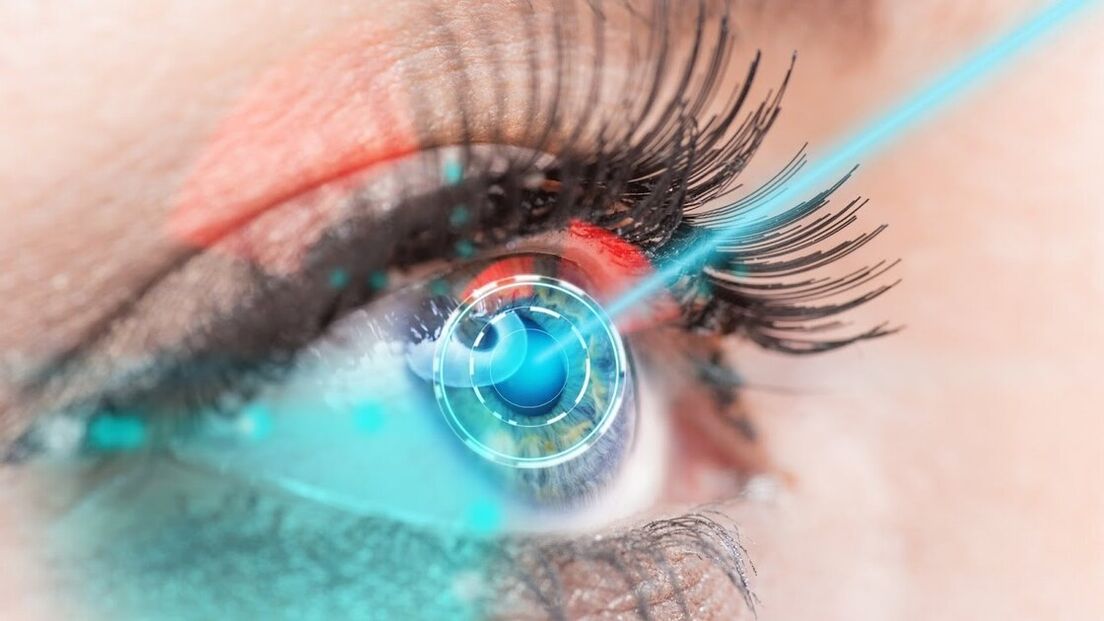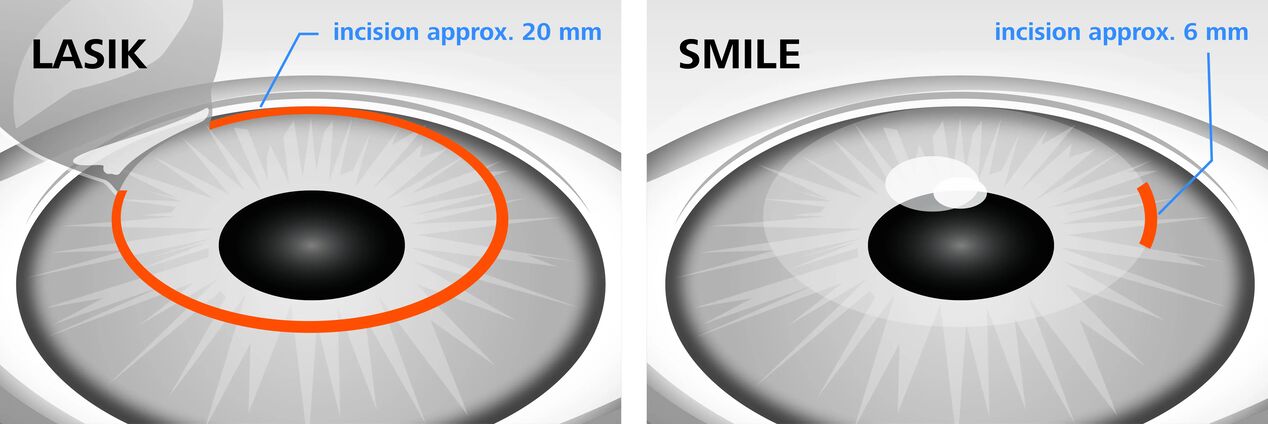
What is LKZ
Indications and contraindications for laser vision correction
- Hyperopia up to +6 diopters.
- Myopia can reach -12 diopters.
- Astigmatism ranges from -4 to +4 diopters.
- During pregnancy and lactation due to unstable hormonal levels.
- If vision loss is observed in the past two years.
- Used for pathologies of corneal structures, chronic inflammatory or infectious diseases of the eye.
- diabetes.
- Immunodeficiency.
- Cataracts and glaucoma.
- Threat of damage, rupture and retinal detachment.
- Thin corneas (determined by special tests).
Advantages and Disadvantages of Laser Vision Correction
- The postoperative results were excellent. Visual acuity is about 100% and is rarely certain even in people without any eye pathology.
- The incidence is low. The recovery period ranges from a few hours to a week and is very short compared to other types of surgical intervention.
- There are no strict restrictions. The preparation and recovery period for laser vision correction does not require patients to significantly change their daily lives. After intervention, you can return to work, study, and sports training almost immediately.
Types of laser vision correction
Photorefractive Keratectomy (PRK)
- The superficial layer of the cornea is removed.
- A laser is used to vaporize corneal tissue (laser ablation).
- Once the cornea has reached the desired shape, a protective lens is installed on top.

- Your eyes become more sensitive to light, so be sure to wear sunglasses with the appropriate level of UV protection during the day.
- Recovery lasts 3 to 5 days. Exceptions include the use of special drops prescribed by a doctor, recommended breaks, working in front of a computer, or working in front of a smartphone or TV screen for long periods of time.
- Mechanical effects on the eyes are excluded. Do not rub, press or impact the damaged area in any other way. Always see your doctor if you experience an accidental injury, severe pain, changes in perspective, or any visual effects on your vision.
- If binocular vision needs to be restored, intervention is performed every 10-14 days. This helps to better cope with post-operative recovery and avoid severe pain.
Laser-Assisted Subepithelial Keratomileusis (LASEK)
- The top layer of the cornea is cut away and the corneal flap is moved to one side. In this case, no scalpel or laser is used, but only an alcohol solution is used to soften the connection between the lower and upper layers of the corneal epithelium.
- The underlying layer is burned with a laser to create the desired shape.
- The flap is placed in its original position and secured with a bandage lens.
- For the first two days, you will experience discomfort and a foreign body sensation in your eyes.
- Drier eyes, which can last up to six months. To eliminate it, special moisturizing drops can be used.
- "Veil" in front of the eyes, worsening of vision at dusk, blurred vision - all these undesirable phenomena may reappear within six months of correction.
Laser-Assisted Keratomileusis (LASIK)
- A flap is formed from the upper layer of the corneal epithelium according to specified parameters.
- Corneal defects were corrected and corrected.
- The flap is returned to its original position to cover the surgical area.
- Super laser surgery.An almost completely automated procedure that can be calibrated to the patient's individual parameters. The cornea is first thoroughly examined, the resulting topography is loaded into the program, and operations are performed according to the program.
- Femtosecond laser surgery.To perform the correction, a special type of laser device is used - a femtosecond laser. He cut off an epithelial flap from the upper layer of the cornea according to prescribed parameters, which greatly facilitated the patient's recovery period. It is characterized by high cost and low risk of complications (about 0. 1%).
- Femto Super LASIK.This technology combines all the advantages of Super Lasik and Femto-LASIK. Recommended for patients with thin corneas and those with severe myopia (up to -25 diopters). This type of laser correction is characterized by the fastest recovery period – patients notice improvements in vision within hours of intervention.
- Presby Laser Surgery.Laser vision correction technology specifically developed after 40 years. Suitable for patients with progressive presbyopia. The main complaint in this case is the inability to fix the view of small elements at close range. If the disease occurs against the background of myopia, the patient is forced to wear two pairs of glasses. During the surgery, the cornea is shaped into a multifocal lens that completely compensates for this vision defect.
- Epi-LASIK.Laser correction methods are rarely used and are usually used in the early or middle stages of myopia or hyperopia. In this case, the cornea has a flatter shape, which allows the corneal flap to be cut along the natural edge (the part of the corneal epithelium). After correction, the flap is returned to its original position and a highly breathable protective lens is attached to it. It must be removed after three days, which requires final recovery. It is important that you continue with your usual routine the next day, including exercise training. That’s why this laser correction method is suitable for active people and patients whose areas of activity involve physical activity.
Femtosecond laser vision correction ReLEx SMILE

Preparing for surgery
- Avoid wearing soft contact lenses for about a week before your consultation. Hard contact lenses that the patient has worn for more than a year should be removed three to four weeks before the appointment. Continued use slightly changes the shape of the cornea, which may cause errors in vision diagnosis and in the calculated trajectory of the laser beam.
- A consultation and examination by an ophthalmologist is necessary before surgery. It is recommended to immediately choose a clinic and carry out the necessary examinations there. At the time of your appointment, a thorough examination of your fundus and vision will be performed. If the patient has no contraindications, the doctor will help you choose the appropriate type of laser correction and perform a corneal typography examination for the upcoming surgery.
- It is important to have a general health check-up. Depending on the treatment plan, necessary procedures include fluoroscopy, checking blood sugar levels, general blood tests, and testing for HIV, syphilis, and hepatitis B and C.
- Women are asked to remove eyelash extensions the day before surgery and refuse to use any decorative cosmetics, creams or lotions.
How does laser correction work and how long does it last?
Postoperative period: recovery, restrictions, post-correction recommendations
- You cannot touch your eyes, touch them with your hands, rub them, or affect them in any other way. This may result in flap displacement and the need for repeated intervention.
- In some cases, patients will wear special protective lenses for three to four days after surgery. They prevent eye injuries, foreign objects or contaminants from entering the eyes.
- In the week following surgery, it is recommended to limit time spent in front of the television, computer screen, or smartphone.
- It is also recommended to avoid additional eye strain, wear sunglasses when going out, and avoid exposure to frost or strong winds.
- Reduce physical activity and avoid heavy lifting and prolonged bending positions.
Possible consequences of laser correction
- The damaged area becomes swollen, inflamed, and bleeds.
- Decreased twilight vision (usually resolves spontaneously 6-9 months after surgery).
- Displacement of the flap due to trauma. Common consequences of patients touching their eyes on the first day after laser correction. In some cases, a second surgery is needed to put everything back into place.























